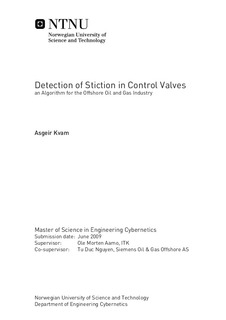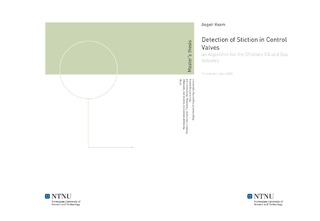| dc.contributor.advisor | Aamo, Ole Morten | nb_NO |
| dc.contributor.advisor | Nguyen, Tu Duc | nb_NO |
| dc.contributor.author | Kvam, Asgeir | nb_NO |
| dc.date.accessioned | 2014-12-19T14:01:52Z | |
| dc.date.available | 2014-12-19T14:01:52Z | |
| dc.date.created | 2010-09-03 | nb_NO |
| dc.date.issued | 2009 | nb_NO |
| dc.identifier | 347745 | nb_NO |
| dc.identifier | ntnudaim:4501 | nb_NO |
| dc.identifier.uri | http://hdl.handle.net/11250/259736 | |
| dc.description.abstract | Valve stiction is one of the largest stand-alone reasons for oscillatory behavior in process industry. It is reported by Siemens Oil and Gas that valve stiction is a problem that is hard and time consuming to detect at offshore production plants for oil and gas. As a result, Siemens Oil and Gas wants to develop an algorithm that detects stiction. The algorithm is thought to be a feature of the logging system of Siemens in the future. To better understand the problem and scope of stiction at a offshore oil and gas production plant, the effects of stiction is studied on a model of such a plant. The study shows that oscillations from stiction in the control valves of a first stage separator easily spread to downstream components such as the connected gas compressor. An algorithm that detects stiction from routine operating data is developed in this thesis. The method in base for the algorithm is chosen from a variety of methods for stiction detection. To choose a suitable method in base for the algorithm a brief survey of methods for detecting stiction is given. The algorithm output is a stiction index that indicate the presence of stiction in the data analyzed. The algorithm detects stiction in data from non-integrating processes with constant inputs and can be applied on data with a varying sample rate. Proper testing on real data from an offshore production plant remains to be done. The algorithm should also be improved to handle data containing noise. Two new ideas of detecting stiction in integrating processes are presented in the end of the thesis. The new ideas try to regain the hidden ellipses in the PV-OP plots from data with stiction from integrating processes. The first idea is to plot the OP data against time shifted PV data, while the second idea is to plot the OP data against high-pass filtered PV data. Both the ideas show promising results but need to be further developed and tested before they can be applied in a future application for stiction detection. | nb_NO |
| dc.language | eng | nb_NO |
| dc.publisher | Institutt for teknisk kybernetikk | nb_NO |
| dc.subject | ntnudaim | no_NO |
| dc.subject | SIE3 teknisk kybernetikk | no_NO |
| dc.subject | Reguleringsteknikk | no_NO |
| dc.title | Detection of Stiction in Control Valves: an Algorithm for the Offshore Oil and Gas Industry | nb_NO |
| dc.type | Master thesis | nb_NO |
| dc.source.pagenumber | 88 | nb_NO |
| dc.contributor.department | Norges teknisk-naturvitenskapelige universitet, Fakultet for informasjonsteknologi, matematikk og elektroteknikk, Institutt for teknisk kybernetikk | nb_NO |

